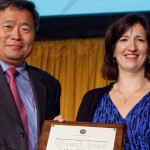Congratulations to Danny Stout! Society for Affective Science Student Poster Award and 1st place at the 2014 UWM Psychology Department Graduate Research Symposium



The University Annual Fall Awards Ceremony was held on October 23rd in the Wisconsin Room. Chris received the UWM Graduate School/UWM Foundation Research Award.

Abstract Asymmetry of waking electroencephalography ~EEG! alpha power in frontal regions has been correlated with waking emotional reactivity and the emotional content of dream reports. Little is known regarding alpha asymmetry during sleep. The present study was performed to compare alpha power and alpha power asymmetry in various brain regions across states of sleep and […]
Abstract Despite the prominence of emotional dysfunction in psychopathology, relatively few experiments have explicitly studied emotion regulation in adults. The present study examined one type of emotion regulation: voluntary regulation of short-term emotional responses to unpleasant visual stimuli. In a sample of 48 college students, both eyeblink startle magnitude and corrugator activity were sensitive to […]
Abstract Emotion is normally regulated in the human brain by a complex circuit consisting of the orbital frontal cortex, amygdala, anterior cingulate cortex, and several other interconnected regions. There are both genetic and environmental contributions to the structure and function of this circuitry. We posit that impulsive aggression and violence arise as a consequence of […]
Abstract Objective: The anterior cingulate cortex has been implicated in depression. Results are best interpreted by considering anatomic and cytoarchitectonic subdivisions. Evidence suggests depression is characterized by hypoactivity in the dorsal anterior cingulate, whereas hyperactivity in the rostral anterior cingulate is associated with good response to treatment. The authors tested the hypothesis that activity in […]
Abstract It is well known that the eating patterns that restrain chronic dieters (restrained eaters) can be disinhibited by anxiety, which in turn has been associated with relative right frontal brain activity in independent electroencephalographic (EEG) studies. Combining these two lines of evidence, the authors tested the hypothesis that chronic restrained eating is associated with […]
Abstract The relationships between brain electrical and metabolic activity are being uncovered currently in animal models using invasive methods; however, in the human brain this relationship remains not well understood. In particular, the relationship between noninvasive measurements of electrical activity and metabolism remains largely undefined. To understand better these relations, cerebral activity was measured simultaneously […]
Abstract Background: Two core characteristics of pathologic fear are its rapid onset and resistance to cognitive regulation. We hypothesized that activation of the amygdala early in the presentation of fear-relevant visual stimuli would distinguish phobics from nonphobics. Methods: Chronometry of amygdala activation to phobia-relevant pictures was assessed in 13 spider phobics and 14 nonphobics using […]
Abstract The authors examined the time course of affective responding associated with different affective dimensions—anxious apprehension, anxious arousal, and anhedonic depression— using an emotionmodulated startle paradigm. Participants high on 1 of these 3 dimensions and nonsymptomatic control participants viewed a series of affective pictures with acoustic startle probes presented before, during, and after the stimuli. […]